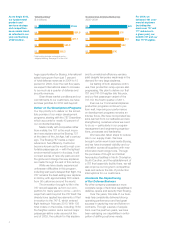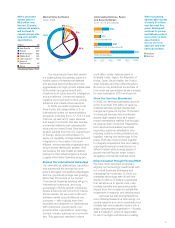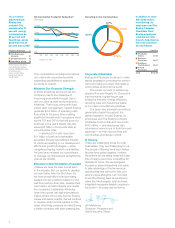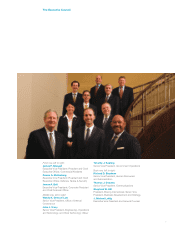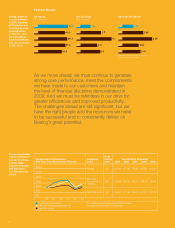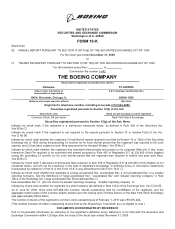Boeing 2009 Annual Report Download - page 16
Download and view the complete annual report
Please find page 16 of the 2009 Boeing annual report below. You can navigate through the pages in the report by either clicking on the pages listed below, or by using the keyword search tool below to find specific information within the annual report.Competition
The commercial jet aircraft market and the airline industry remain extremely competitive. We face
aggressive international competitors, including Airbus, who are intent on increasing their market share.
We are focused on improving our processes and continuing cost reduction efforts. We continue to
leverage our extensive customer support services network which includes aviation support, spares,
training, maintenance documents and technical advice for airlines throughout the world to provide a
higher level of customer satisfaction and productivity.
BDS faces strong competition in all market segments, primarily from Lockheed Martin Corporation,
Northrop Grumman Corporation, Raytheon Company and General Dynamics Corporation. Non-U.S.
companies such as BAE Systems and European Aeronautic Defence and Space Company (EADS),
the parent of Airbus, continue to pursue a strategic presence in the U.S. market by strengthening their
North American operations and partnering with U.S. defense companies. In addition, certain of our
competitors have occasionally formed teams with other competitors to address specific customer
requirements. BDS expects the trend of strong competition to continue into 2010 with many
international firms pursuing announced intentions of increasing their U.S. presence.
Regulatory Matters
Our businesses are heavily regulated in most of our markets. We deal with numerous U.S. government
agencies and entities, including but not limited to all of the branches of the U.S. military, NASA and the
Department of Homeland Security. Similar government authorities exist in our international markets.
U.S. Government Contracts. The U.S. government, and other governments, may terminate any of our
government contracts at their convenience as well as for default based on our failure to meet specified
performance measurements. If any of our government contracts were to be terminated for
convenience, we generally would be entitled to receive payment for work completed and allowable
termination or cancellation costs. If any of our government contracts were to be terminated for default,
generally the U.S. government would pay only for the work that has been accepted and can require us
to pay the difference between the original contract price and the cost to re-procure the contract items,
net of the work accepted from the original contract. The U.S. government can also hold us liable for
damages resulting from the default.
Commercial Aircraft. In the United States, our commercial aircraft products are required to comply with
Federal Aviation Administration regulations governing production and quality systems, airworthiness
and installation approvals, repair procedures and continuing operational safety. Internationally, similar
requirements exist for airworthiness, installation and operational approvals. These requirements are
generally administered by the national aviation authorities of each country and, in the case of Europe,
coordinated by the European Joint Aviation Authorities.
Environmental. Our operations are subject to and affected by a variety of federal, state, local and
non-U.S. environmental laws and regulations relating to the discharge, treatment, storage, disposal,
investigation and remediation of certain materials, substances and wastes. We continually assess our
compliance status and management of environmental matters to ensure our operations are in
substantial compliance with all applicable environmental laws and regulations.
Operating and maintenance costs associated with environmental compliance and management of sites
are a normal, recurring part of our operations. These costs often are allowable costs under our
contracts with the U.S. government. It is reasonably possible that continued environmental compliance
could have a material impact on our results of operations, financial condition or cash flows if more
stringent clean-up standards are imposed, additional contamination is discovered and/or clean-up
costs are higher than estimated.
4


